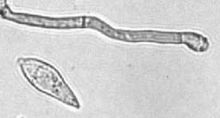| Magnaporthe grisea | |
|---|---|

| |
| Conidium and conidiogenous cell | |
| Scientific classification | |
| Domain: | Eukaryota |
| Kingdom: | Fungi |
| Division: | Ascomycota |
| Class: | Sordariomycetes |
| Order: | Magnaporthales |
| Family: | Magnaporthaceae |
| Genus: | Magnaporthe |
| Species: | M. grisea
|
| Binomial name | |
| Magnaporthe grisea (T.T. Hebert) M.E. Barr
| |
| Synonyms | |
|
Ceratosphaeria grisea T.T. Hebert, (1971) | |
Magnaporthe grisea, also known as rice blast fungus, rice rotten neck, rice seedling blight, blast of rice, oval leaf spot of graminea, pitting disease, ryegrass blast, Johnson spot,[1][2][3][4][5][6][7] neck blast,[8][9][10][11] wheat blast[12] and Imochi (稲熱), is a plant-pathogenic fungus and model organism[13] that causes a serious disease affecting rice. It is now known that M. grisea consists of a cryptic species complex containing at least two biological species that have clear genetic differences and do not interbreed.[14] Complex members isolated from Digitaria have been more narrowly defined as M. grisea. The remaining members of the complex isolated from rice and a variety of other hosts have been renamed Magnaporthe oryzae, within the same M. grisea complex.[14] Confusion on which of these two names to use for the rice blast pathogen remains, as both are now used by different authors.
Members of the M. grisea complex can also infect other agriculturally important cereals including wheat, rye, barley, and pearl millet causing diseases called blast disease or blight disease. Rice blast causes economically significant crop losses annually. Each year it is estimated to destroy enough rice to feed more than 60 million people. The fungus is known to occur in 85 countries worldwide[15] and as of 2003[update] was the most devastating fungal plant pathogen in the world.[13]
- ^ Cite error: The named reference
Serial-Killerwas invoked but never defined (see the help page). - ^ Zeigler, RS; Leong, SA; Teeng, PS (1994). "Rice Blast Disease." Wallingford, UK: CABI Centre for Agriculture and Bioscience International.
- ^ Wilson, R. A.; Talbot, N. J. (2009). "Under pressure: Investigating the biology of plant infection by Magnaporthe oryzae". Nature Reviews Microbiology. 7 (3): 185–95. doi:10.1038/nrmicro2032. PMID 19219052. S2CID 42684382.
- ^ Sesma, A.; Osbourn, A. E. (2004). "The rice leaf blast pathogen undergoes developmental processes typical of root-infecting fungi". Nature. 431 (7008): 582–6. Bibcode:2004Natur.431..582S. doi:10.1038/nature02880. PMID 15457264. S2CID 549194.
- ^ Dean, R. A.; Talbot, N. J.; Ebbole, D. J.; Farman, M. L.; Mitchell, T. K.; Orbach, M. J.; Thon, M; Kulkarni, R; Xu, J. R.; Pan, H; Read, N. D.; Lee, Y. H.; Carbone, I; Brown, D; Oh, Y. Y.; Donofrio, N; Jeong, J. S.; Soanes, D. M.; Djonovic, S; Kolomiets, E; Rehmeyer, C; Li, W; Harding, M; Kim, S; Lebrun, M. H.; Bohnert, H; Coughlan, S; Butler, J; Calvo, S; et al. (2005). "The genome sequence of the rice blast fungus Magnaporthe grisea". Nature. 434 (7036): 980–6. Bibcode:2005Natur.434..980D. doi:10.1038/nature03449. PMID 15846337.
- ^ Couch, B. C.; Kohn, L. M. (2002). "A multilocus gene genealogy concordant with host preference indicates segregation of a new species, Magnaporthe oryzae, from M. grisea". Mycologia. 94 (4): 683–93. doi:10.2307/3761719. JSTOR 3761719. PMID 21156541.
- ^ Magnaporthe grisea Archived 2007-10-12 at the Wayback Machine at Crop Protection Compendium Archived 2007-07-16 at the Wayback Machine, CAB International
- ^ Te Beest (2007). "Rice Blast". The Plant Health Instructor. American Phytopathological Society (APS). doi:10.1094/phi-i-2007-0313-07. ISSN 1935-9411.
- ^ Khan, Mohammad Ashik Iqbal; Rejwan Bhuiyan, Mohammad; Hossain, Mohammad Shahadat; Pratim Sen, Partha; Ara, Anjuman; Abubakar Siddique, Md; Ansar Ali, Md (2014). "Neck blast disease influences grain yield and quality traits of aromatic rice". Comptes Rendus Biologies. 337 (11). Elsevier Masson: 635–641. doi:10.1016/j.crvi.2014.08.007. ISSN 1631-0691. PMID 25444707.
- ^ Roumen, E. C. (1992). "Partial resistance to neck blast influenced by stage of panicle development and rice genotype". Euphytica. 64 (3). Springer Science and Business Media LLC: 173–182. doi:10.1007/bf00046046. ISSN 0014-2336. S2CID 45126761.
- ^ Titone, Patrizia; Mongiano, Gabriele; Tamborini, Luigi (2015-01-04). "Resistance to neck blast caused by Pyricularia oryzae in Italian rice cultivars". European Journal of Plant Pathology. 142 (1). Springer Science and Business Media LLC: 49–59. Bibcode:2015EJPP..142...49T. doi:10.1007/s10658-014-0588-1. ISSN 0929-1873. S2CID 14478689.
- ^ Cite error: The named reference
Kumarwas invoked but never defined (see the help page). - ^ a b Cite error: The named reference
Yarden-et-al-2003was invoked but never defined (see the help page). - ^ a b Couch, B. C.; Fudal, I; Lebrun, M. H.; Tharreau, D; Valent, B; Van Kim, P; Nottéghem, J. L.; Kohn, L. M. (2005). "Origins of host-specific populations of the blast pathogen Magnaporthe oryzae in crop domestication with subsequent expansion of pandemic clones on rice and weeds of rice". Genetics. 170 (2): 613–30. doi:10.1534/genetics.105.041780. PMC 1450392. PMID 15802503.
- ^ Cite error: The named reference
Californiawas invoked but never defined (see the help page).